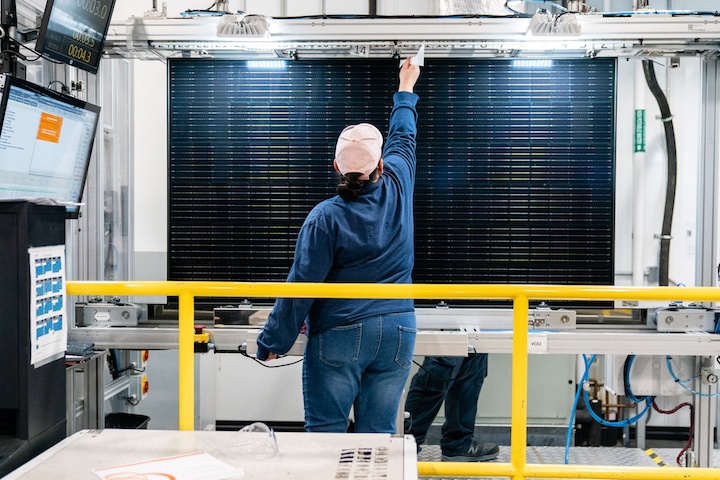US solar makers seek additional tariffs on panel imports from Asia
Solar manufacturers are asking the US government to slap duties on $12.5 billion of imported equipment from Southeast Asia, setting the stage for a sweeping trade probe that threatens to make power projects more expensive.
In petitions filed Wednesday, seven panel makers and polysilicon producers seek trade help to counteract what they say are unfair practices by overseas rivals. Their requests raise the prospect of tariffs as high as 271.5% later this year.
While another batch of tariffs could bolster US solar manufacturing — a priority for President Joe Biden — the move also threatens to heighten uncertainty for a renewable power industry needed to fight climate change and meet soaring electricity demand.

First Solar Inc., America’s biggest solar manufacturer, rose as much as 2% in intraday trading Wednesday.
Biden’s Inflation Reduction Act delivered tens of billions of dollars in subsidies for new solar factories. But the country still depends on imports from Asia for most of its panel supply — and domestic manufacturers argue the US government support has been undermined by other federal policies as well as a surge of cheap imports.
Those imports — worth $12.5 billion over the past 12 months — threaten “the existence of the emerging domestic solar manufacturing industry and the billions of dollars of US investments” in it, said Tim Brightbill, co-chair of Wiley Rein LLP’s international trade practice and lead counsel for the petitioners. “All of the recent investment in US solar manufacturing — including billions of dollars worth from the Inflation Reduction Act — is now at risk.”
The complaints from manufacturers Convalt Energy Inc., First Solar Inc., Hanwha Qcells USA Inc., Meyer Burger (Americas) Ltd., Mission Solar Energy LLC, REC Silicon ASA and Swift Solar Inc. focus on solar cells from Cambodia, Malaysia, Thailand and Vietnam. Those countries constitute about 80% of US panel imports.
The US solar makers, united as the American Alliance for Solar Manufacturing Trade Committee, want a government investigation — and duties ranging from 70.4% to 271.5% on the imports. They allege the equipment is being sold at prices below the cost of production — and unfairly benefits from tens of billions of dollars in subsidies, including from entities of the Chinese government.
The petitions come months after a US government probe found Chinese companies were bypassing existing tariffs by assembling their panels in those nations.
Some renewable power advocates condemned the tariff push and asked the Biden administration to consider alternative solutions to address the manufacturers’ concerns.
“We are deeply concerned” the “petitions will lead to further market volatility across the US solar and storage industry and create uncertainty at a time when we need effective solutions that support US solar manufacturers,” the Solar Energy Industries Association, American Clean Power Association, Advanced Energy United and the American Council on Renewable Energy said in a joint statement.
Some developers have brushed aside concerns. John Ketchum, the chief executive officer of NextEra Energy Inc., said Tuesday he expected any new trade actions to be “very manageable,” in part because they are unlikely to halt deliveries.
The White House declined to comment on the specifics of the petitions, but spokesman Angelo Fernandez Hernandez emphasized the “unprecedented surge in announced investment in solar manufacturing” unleashed by the Inflation Reduction Act.
“We will build on this progress and continue to work with manufacturers, developers and unions to ensure that the US leads in solar manufacturing and deployment in support of our ambitious climate goals,” he said.
Now that the petitions have been filed, the next step is for the US Commerce Department to determine whether the manufacturers’ petitions meet necessary requirements to launch a probe — with a decision expected in the next 20 days. It could take the Commerce Department and International Trade Commission nearly a year to determine whether import tariffs are warranted, but preliminary duties may be imposed in about four months.
While solar power advocates argue new trade investigations could hike project costs and slow development, Brightbill contends the US has large stockpiles of unused panels — enough to supply projects for at least 18 months — and the equipment makes up only a small fraction of total project costs.
“Solar is already the cheapest form of electricity — and these cases will not change that,” he said. “A level playing field where market-distorting anticompetitive behavior is effectively addressed gives US solar manufacturers the ability to compete on a global scale without slowing down solar deployment.”
The US manufacturers are alleging dumping margins of 126.1% on Cambodia, 81.2% on Malaysia, 70.4% on Thailand and 271.5% on Vietnam. Customarily, when dumping is found to be occurring and harming US producers, actual rates are much lower than initially alleged.
Similar Stories
United States and Norway issue innovative report creating greater transparency in critical mineral supply chains
Today, the U.S. Department of Commerce and the Norwegian Ministry of Trade, Industry, and Fisheries issued a thorough, innovative report presenting our shared understanding of non-market policies and practices (NMPPs)…
View Article
Rising data demand puts pressure on US energy grid, boosts gas projects / Rystad Energy
View Article
EIA extends five key energy forecasts through December 2026
View Article
New interagency study finds expansion of renewable energy production on federal lands could power millions more American homes
View ArticleEIA Short-Term Energy Outlook
This edition of our STEO is the first to include forecasts for 2026.
View Article
EIA publishes its first energy-sector forecasts through 2026
View ArticleGet the most up-to-date trending news!
SubscribeIndustry updates and weekly newsletter direct to your inbox!





